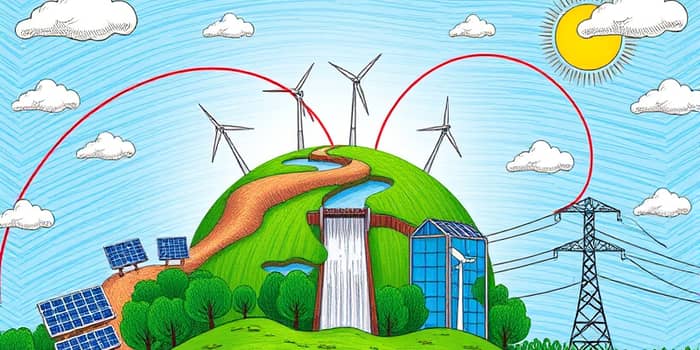
In a world facing accelerating climate change and growing technological demands, energy stands at the core of progress. This article explores the state of electricity, the rise of renewables, and the innovative forces reshaping power production and consumption. By examining recent data, regional dynamics, and future targets, we aim to empower readers with insights and practical guidance for engaging with the energy transition.
As economies rebound from recent disruptions, global energy consumption rose by 2.2% in 2024 and into 2025, signaling a shift from the slower growth of the previous decade. Driven by industrial expansion, rising living standards, and a push toward electrification, total demand is no longer plateauing. Electricity, in particular, soared in importance:
During the same period, electricity demand surged by more than 4%, outpacing the overall energy growth. This spike reflects the rapid adoption of electric vehicles, the proliferation of data centers, and extreme weather driving cooling needs.
Key drivers include:
Renewable energy continues to redefine the global supply mix. In 2024 alone, renewable sources provided 32% of global electricity, the highest share on record. Solar PV and wind installations led the charge, adding remarkable new capacity.
Approximately 700 GW of renewable capacity added in 2024, of which nearly 80% was solar PV. Since 2010, the expansion of renewables and nuclear power has helped the world avoid 1,371 exajoules of fossil fuel use and prevented roughly 110 gigatonnes of greenhouse gas emissions.
The Asia Pacific region led global power generation growth at 5.4% in 2024, driven by China’s massive deployment of both renewables and coal. The BRICS nations collectively accounted for 43% of global energy consumption, with China alone responsible for over half of global electricity demand growth and a record 58% share of world coal use.
Meanwhile, the United States, Europe, and China captured roughly 75% of all new solar capacity. In Europe, a landmark achievement saw solar PV and wind together exceed coal and gas for the first time, signaling a pivotal moment in the transition toward clean energy leadership.
Despite the surge in renewables, fossil fuels remain a dominant force. Global coal consumption slowed in most regions except China, and both oil and gas demand continue to grow, albeit at a slower pace than renewables. As a result, CO₂ emissions from energy use are still rising, though the rate of increase has begun to decelerate.
Energy-related emissions reached new highs in 2024, exacerbated by extreme temperature records worldwide. However, the incremental shift to cleaner power sources offers a pathway to bending the emissions curve downward over the coming decades.
Policymakers have set lofty goals to drive the energy transition. COP28 underscored the need for tripling global renewable capacity to 11,000 GW by 2030, which implies adding roughly 950 GW each year. Fulfilling this ambition will require stronger incentives, deeper financing, and cross-border cooperation on grid integration.
Hydrogen is also emerging as a key vector for decarbonization. Under aggressive climate scenarios, hydrogen could supply 4–7% of final energy consumption by 2050, replacing some fossil fuel uses in heavy industry and transport. Yet in most conservative forecasts, it remains below 1% through the decade.
Long-term projections indicate that renewables could account for 37–74% of the world’s electricity by 2050, depending on policy ambition and technological innovation. Meanwhile, global primary energy demand is expected to plateau between 600 and 750 Quadrillion BTU, driven by gains in energy efficiency.
The shift toward electrification is not just an industrial story; it touches every household. Homes and businesses increasingly rely on electric heating, cooling, and transport solutions. In many regions, wind and solar now cheapest sources of electricity, empowering both urban and rural communities with cleaner, more affordable power.
Digitalization further amplifies energy demand, as data centers and AI drive higher electricity use around the clock. However, smarter grid management and demand-response technologies offer tools to balance loads and integrate higher shares of renewables without compromising reliability.
Energy efficiency remains a fundamental pillar of the transition. From advanced building materials to smart appliances, incremental improvements help flatten demand curves, reducing the strain on supply systems and lowering costs for consumers.
For policymakers, industry leaders, and citizens alike, the path forward is clear: accelerate decarbonization while ensuring equitable access to energy services. Practical steps include:
Businesses can align their operations with science-based targets, foster innovation in storage and smart grids, and partner with research institutions to de-risk emerging technologies. Individuals can reduce their carbon footprint by choosing green energy tariffs, installing rooftop solar, and adopting energy-efficient lifestyles.
Collectively, these efforts can sustain momentum toward a resilient, equitable, and low-carbon energy system.
The power of energy in 2025 is a story of both challenge and opportunity. As consumption patterns evolve and renewable technologies mature, the global community stands at a crossroads. By harnessing policy frameworks, technological advancements, and societal engagement, we can transform the energy landscape and secure a sustainable future for generations to come.
Understanding the data, embracing innovative solutions, and taking meaningful action at every level is the key to unlocking the true power of energy.
References





